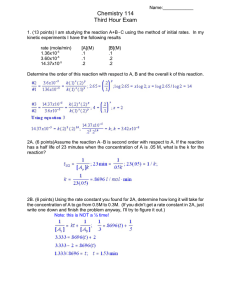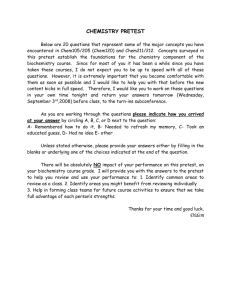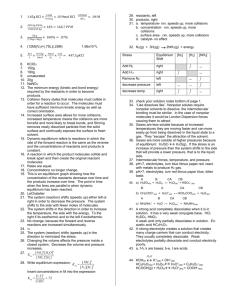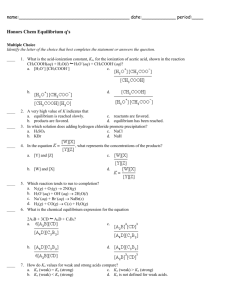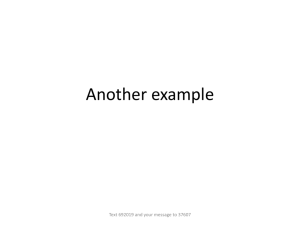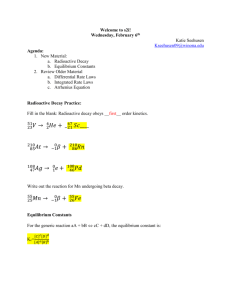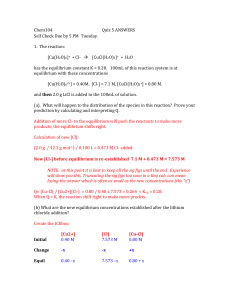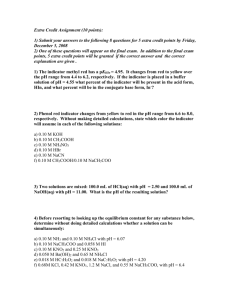Chemical Equilibrium
advertisement
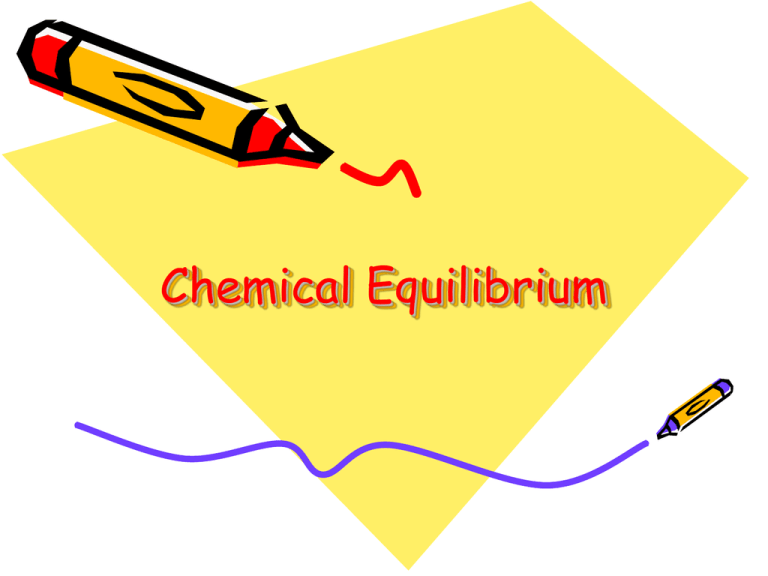
Chemical Equilibrium Reversible Reactions Freezing Ice? Cooking an egg? Melting water? • Reversible reactions are those in which the products can react to re-form reactants. • Ex: 2HgO (s) + heat -------------> 2Hg (l) + O2 (g) 2Hg (l) + O2 (g) -------------> 2HgO (s) + heat • Chemical Equilibrium: When the rate of the forward reaction = the rate of the reverse reaction AND the concentrations of product and reactants remain the same. Equilibrium • If product is favored, the reaction is represented as: + (aq) + Br- (aq) HBr (aq) + H2O(l) --------> H O 3 <--• If reactant is favored, the reaction is represented as: + H2CO3 (aq) + H2O (l) ---> <------ H3O (aq) + HCO3 (aq) • If concentrations of reactants = products: H2SO3 (aq) + H2O (l) -------> <------- H3O+ (aq) + HSO3- (aq) • The extent to which reactants ----> product is determined from the equilibrium constant. The Equilibrium Expression • Since the concentrations of reactants and products after equilibrium has been established remain constant, so does the ratio of reactant to product. Ex: nA(aq)+ mB(aq) -------> xC(aq) + yD(aq) • K = [C]x[D]y K is determined experimentally [A]n[B]m K is dependent on temperature No solids or liquid included in the equilibrium expression If K > 1, product is favored If K < 1, reactant is favored If K = 1, reactant = product Question • What is the equilibrium expression for the following reaction at equilibrium? ------> • H2(g) + I2 (g) <------ HI (g) • K = [HI]2 [H2][I2] • The equilibrium expression can be used to calculate concentrations of reactants and products at equilibrium. Let’s try… Predicting Direction of a Shift in Equilbrium • Le Chatelier’s Principle: If a stress is applied to a system at equilbrium, the system will react in a way to minimize that stress. • Changes in pressure: – Affect gases only! • Changes in temperature • Changes in concentration: – Solids and liquids not affected. - K is not affected. Reactions that Go to Completion • In these reactions, ions are almost completely removed from solution. • Formation of a gas – Ex: H2CO3 (aq) H20 (l) + CO2 (g) • Formation of a precipitate – Ex: NaCl(aq) + AgNO3(aq) NaNO3 + AgCl (s) • Formation of a slightly ionized product (acids and bases) Ex: HCl(aq) + NaOH(aq) NaCl(s) + H2O(l) Common Ion Effect • When the addition of an ion common to 2 solutes brings about precipitation. --------> • Ex: NaCl (s) <-------- Na+ (aq) + Cl- (aq) • If I now add HCl to this solution, which ion will be affected? • HCl(g) + H2O(l) -----> H3O+(aq) + Cl-(aq) • Equilibrium will shift to the left (production of Solid NaCl) Equilibria of Acids, Bases and Salts • Ionization of a Weak Acid -------> CH3COOH + H2O <------- H3O+ + CH3COO• K = [H3O+ ][CH3COO-]/[CH3COOH][H2O] • We can assume that the [H2O] remains constant. • K[H2O] = [H3O+ ][CH3COO-] = Ka Acid Ionization Constant [CH3COOH] Ka • Constant at a given temperature. • For weak acids, Ka is < 1. • To determine the Ka, the [ ] of involved reactants/products must be known. • [ ] are found by measuring pH. • Kb used for bases. Buffers Resist changes in pH • Weak acid + its salt (or weak base + salt) • Salts of a weak acid can combine with the extra H3O+ that is produced. – Ex: CH3COOH/NaCH3COO solution – CH3COO- + H3O+ ----> CH3COOH + H2O Buffered Solution Acid first ―CH COO3 Buffered Solution second ―CH No pH change + H+ + OH- H20 Base - + H O+ COOH + H 0 CH COO 3 2 3 3 Offsets original base Hydrolysis of Salts • Salts formed during neutralization • Hydrolysis occurs when water molecules combine with ions of a dissolved salt. • Can form acidic, basic or neutral solutions: – – – – Strong Acid + Strong Base -----> Neutral Strong Acid + Weak Base -----> Acidic Strong Base + Weak Acid -----> Basic Weak Base + Weak Acid ------> Unpredictable Solubility Equilibrium • Used to predict whether precipitation occurs when solutions are combined. • Soluble (>1 g/100 g water) • Ex: AgCl (s) -----> Ag+ (aq) + Cl-(aq) • Ksp = [Ag+][Cl-] = Solubility Product Constant – If Ksp > ion product, the substance DISSOLVES (unsaturated- no solid present) – If Ksp < ion product, there is PRECIPITATION − Pg. 579 Table 18-3
